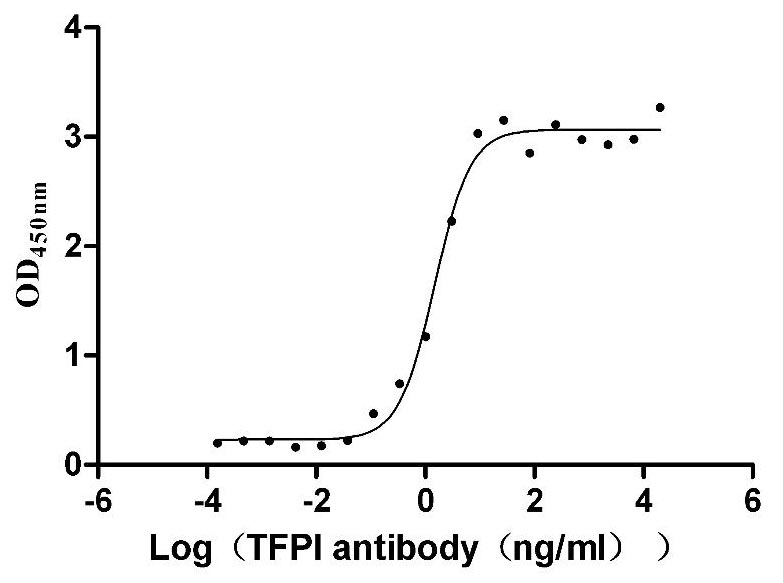Recombinant Rat E3 ubiquitin-protein ligase SH3RF1 (Sh3rf1), partial
-
中文名稱:大鼠Sh3rf1重組蛋白
-
貨號:CSB-YP765143RA
-
規(guī)格:
-
來源:Yeast
-
其他:
-
中文名稱:大鼠Sh3rf1重組蛋白
-
貨號:CSB-EP765143RA
-
規(guī)格:
-
來源:E.coli
-
其他:
-
中文名稱:大鼠Sh3rf1重組蛋白
-
貨號:CSB-EP765143RA-B
-
規(guī)格:
-
來源:E.coli
-
共軛:Avi-tag Biotinylated
E. coli biotin ligase (BirA) is highly specific in covalently attaching biotin to the 15 amino acid AviTag peptide. This recombinant protein was biotinylated in vivo by AviTag-BirA technology, which method is BriA catalyzes amide linkage between the biotin and the specific lysine of the AviTag.
-
其他:
-
中文名稱:大鼠Sh3rf1重組蛋白
-
貨號:CSB-BP765143RA
-
規(guī)格:
-
來源:Baculovirus
-
其他:
-
中文名稱:大鼠Sh3rf1重組蛋白
-
貨號:CSB-MP765143RA
-
規(guī)格:
-
來源:Mammalian cell
-
其他:
產(chǎn)品詳情
-
純度:>85% (SDS-PAGE)
-
基因名:Sh3rf1
-
Uniprot No.:
-
別名:Sh3rf1; Posh; Posh1; Sh3md2; E3 ubiquitin-protein ligase SH3RF1; EC 2.3.2.27; Plenty of SH3s; Protein POSH; RING-type E3 ubiquitin transferase SH3RF1; SH3 domain-containing RING finger protein 1; SH3 multiple domains protein 2
-
種屬:Rattus norvegicus (Rat)
-
蛋白長度:Partial
-
蛋白標簽:Tag?type?will?be?determined?during?the?manufacturing?process.
The tag type will be determined during production process. If you have specified tag type, please tell us and we will develop the specified tag preferentially. -
產(chǎn)品提供形式:Lyophilized powder
Note: We will preferentially ship the format that we have in stock, however, if you have any special requirement for the format, please remark your requirement when placing the order, we will prepare according to your demand. -
復(fù)溶:We recommend that this vial be briefly centrifuged prior to opening to bring the contents to the bottom. Please reconstitute protein in deionized sterile water to a concentration of 0.1-1.0 mg/mL.We recommend to add 5-50% of glycerol (final concentration) and aliquot for long-term storage at -20℃/-80℃. Our default final concentration of glycerol is 50%. Customers could use it as reference.
-
儲存條件:Store at -20°C/-80°C upon receipt, aliquoting is necessary for mutiple use. Avoid repeated freeze-thaw cycles.
-
保質(zhì)期:The shelf life is related to many factors, storage state, buffer ingredients, storage temperature and the stability of the protein itself.
Generally, the shelf life of liquid form is 6 months at -20°C/-80°C. The shelf life of lyophilized form is 12 months at -20°C/-80°C. -
貨期:Delivery time may differ from different purchasing way or location, please kindly consult your local distributors for specific delivery time.Note: All of our proteins are default shipped with normal blue ice packs, if you request to ship with dry ice, please communicate with us in advance and extra fees will be charged.
-
注意事項:Repeated freezing and thawing is not recommended. Store working aliquots at 4°C for up to one week.
-
Datasheet :Please contact us to get it.
靶點詳情
-
功能:Has E3 ubiquitin-protein ligase activity. In the absence of an external substrate, it can catalyze self-ubiquitination. Stimulates ubiquitination of potassium channel KCNJ1, enhancing it's dynamin-dependent and clathrin-independent endocytosis. Acts as a scaffold protein that coordinates with MAPK8IP1/JIP1 in organizing different components of the JNK pathway, including RAC1 or RAC2, MAP3K11/MLK3 or MAP3K7/TAK1, MAP2K7/MKK7, MAPK8/JNK1 and/or MAPK9/JNK2 into a functional multiprotein complex to ensure the effective activation of the JNK signaling pathway. Regulates the differentiation of CD4(+) and CD8(+) T-cells and promotes T-helper 1 (Th1) cell differentiation. Regulates the activation of MAPK8/JNK1 and MAPK9/JNK2 in CD4(+) T-cells and the activation of MAPK8/JNK1 in CD8(+) T-cells. Plays a crucial role in the migration of neocortical neurons in the developing brain. Controls proper cortical neuronal migration and the formation of proximal cytoplasmic dilation in the leading process (PCDLP) in migratory neocortical neurons by regulating the proper localization of activated RAC1 and F-actin assembly.
-
基因功能參考文獻:
- a model in which Sh3rf2 promotes proteasomal degradation of pro-apoptotic POSH in healthy cells and in which apoptotic stimuli lead to rapid loss of Sh3rf2 expression, and consequently to stabilization of POSH and JNK activation and cell death PMID: 22128169
- POSH's ability to induce apoptosis is correlated with its stability as well as its MLK binding ability. PMID: 21203929
- POSH might serve as a scaffold mediating JNK signalling activation in the hippocampal CA1 region following cerebral ischaemia PMID: 16248889
- Nix promotes cell death via interaction with POSH and activation of the JNK/c-Jun pathway and that Nix protein is induced and contributes to cell death in a cellular model of Parkinson disease PMID: 17095503
- POSH inhibits ROMK channels by enhancing dynamin-dependent and clathrin-independent endocytosis and by stimulating ubiquitination of ROMK channels. PMID: 19710010
顯示更多
收起更多
-
亞細胞定位:Cytoplasm, perinuclear region. Cell projection, lamellipodium. Golgi apparatus, trans-Golgi network.
-
蛋白家族:SH3RF family
-
數(shù)據(jù)庫鏈接:
Most popular with customers
-
Recombinant Human Tissue factor pathway inhibitor (TFPI), partial (Active)
Express system: Mammalian cell
Species: Homo sapiens (Human)
-
Recombinant Human Intestinal-type alkaline phosphatase (ALPI) (Active)
Express system: Mammalian cell
Species: Homo sapiens (Human)
-
Express system: Mammalian cell
Species: Homo sapiens (Human)
-
Recombinant Human C-C chemokine receptor type 8 (CCR8)-VLPs (Active)
Express system: Mammalian cell
Species: Homo sapiens (Human)
-
Recombinant Macaca fascicularis CUB domain containing protein 1 (CDCP1), partial (Active)
Express system: Mammalian cell
Species: Macaca fascicularis (Crab-eating macaque) (Cynomolgus monkey)
-
Recombinant Human C-C chemokine receptor type 6(CCR6)-VLPs (Active)
Express system: Mammalian cell
Species: Homo sapiens (Human)
-
Recombinant Human Transmembrane 4 L6 family member 1(TM4SF1)-VLPs (Active)
Express system: Mammalian cell
Species: Homo sapiens (Human)
-
Recombinant Macaca fascicularis Cadherin 6(CDH6),partial (Active)
Express system: Mammalian cell
Species: Macaca fascicularis (Crab-eating macaque) (Cynomolgus monkey)


















